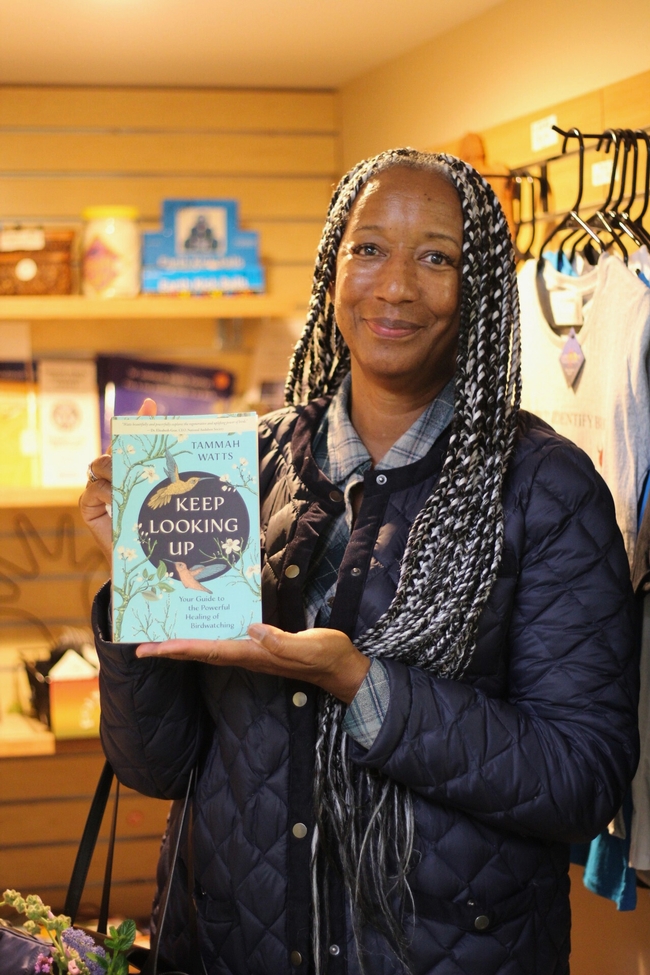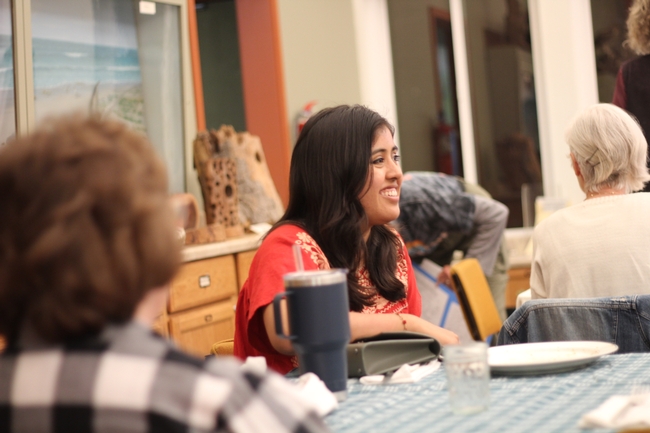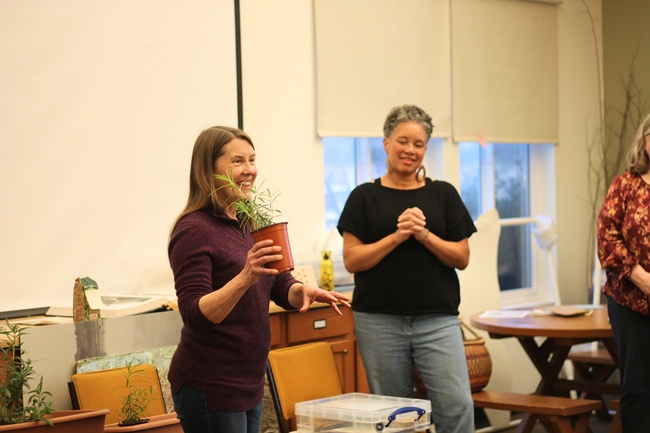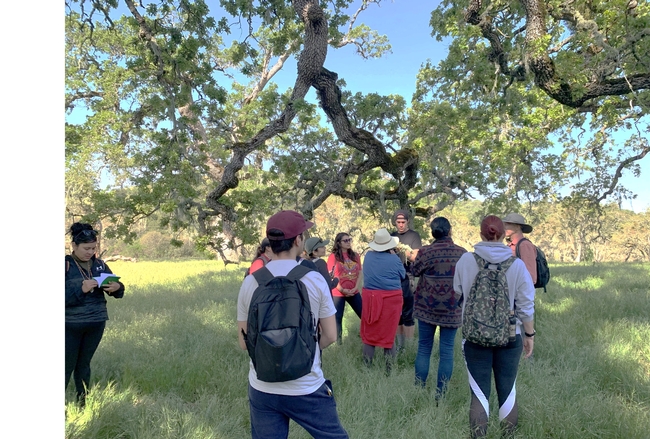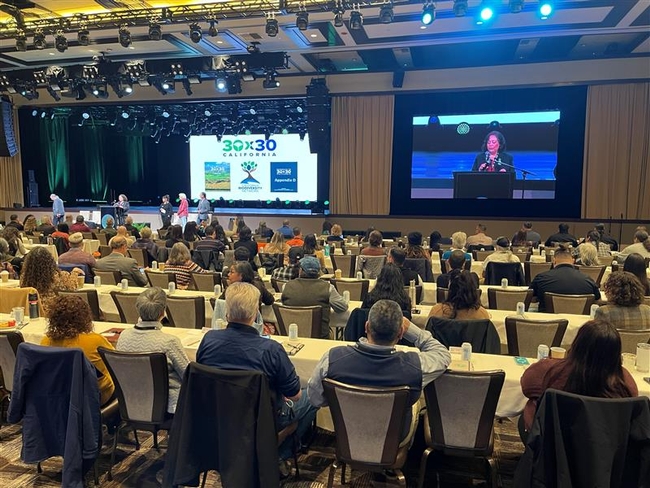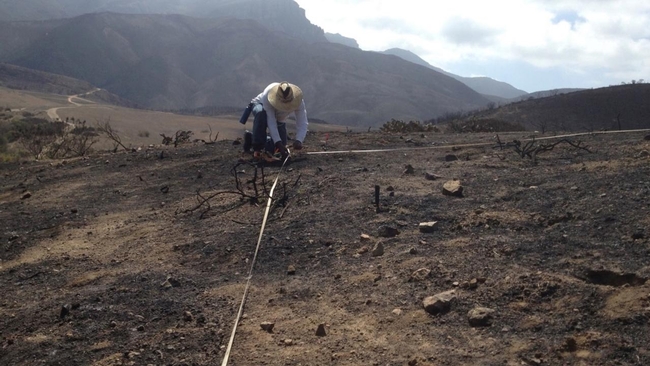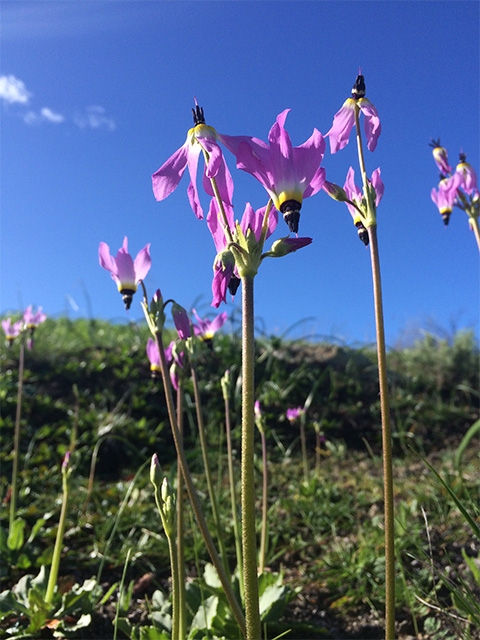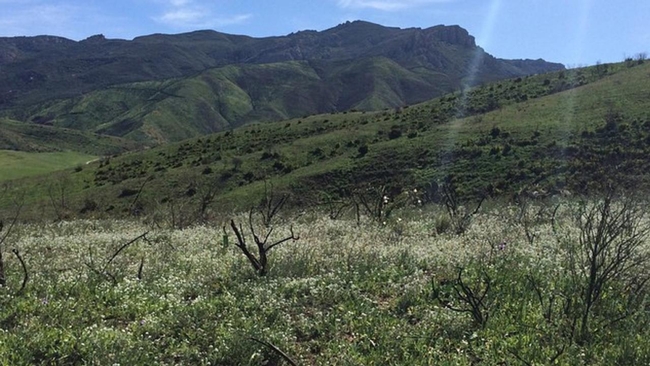
Posts Tagged: native
Monarchs and California Golden Poppies: Color Them Orange
Monarchs and California golden poppies...Color them orange...Color them bold...Color them beautiful... And color them natives... The California golden poppy, Eschscholzia californica, California's state flower, is popping up all over, while monarchs, Danaus plexippus, are winging their...
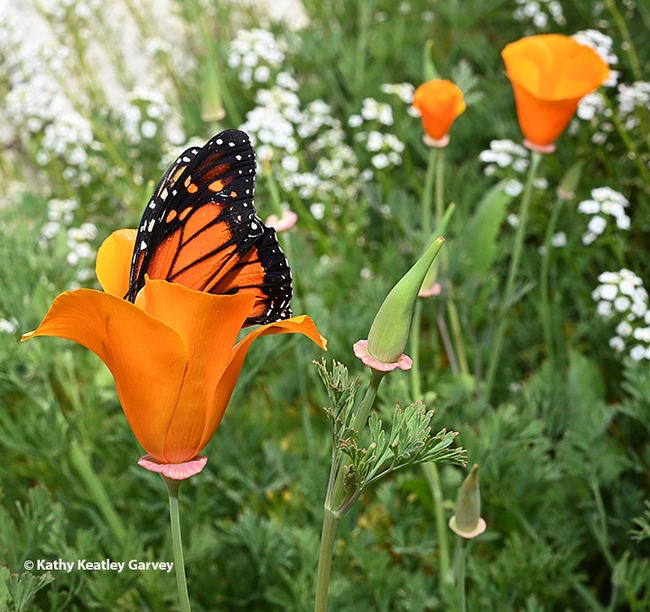
Color them orange: A California golden poppy and a monarch butterfly in a Vacaville garden. (Photo by Kathy Keatley Garvey)
New UC California Naturalists inspire care for nature in San Diego County
Nearly 200 residents trained in past seven years by program, a part of UC Environmental Stewards
On one of her darkest days, Tammah Watts stood in front of her kitchen sink to fill a pitcher of water. Outside of her window, the San Marcos resident noticed a flutter in the distance. She spotted a small yellow bird emerge from the tree and her eyes grew in admiration.
Bird-watching from her kitchen window became an escape for Watts while she was temporarily homebound after a surgery. It's where she found connection beyond the interior space of her home.
“I started noticing other birds that had always been there. The yard didn't change, but my mind and my perspective did,” she said.
Eager to learn more and expose others to her new hobby and its healing power, Watts joined the University of California Environmental Stewards program, a statewide program housed under UC Agriculture and Natural Resources, to become a certified California Naturalist.
The program offers two environmental education certification courses: the California Naturalist course, which introduces people to the wonders of California's unique ecology and engages the public in the study and stewardship of the state's natural communities, and a separate Climate Stewards course.
One of the many strengths of the program is that it allows people from diverse backgrounds to find common ground in nature even if how they became interested varies, said Eliot Freutel, a community education specialist for the UC Environmental Stewards program in Southern California.
“Our partners that help us administer the course are organizations that already have access to the public and provide informal science education, such as natural history museums or Audubon societies,” Freutel added.
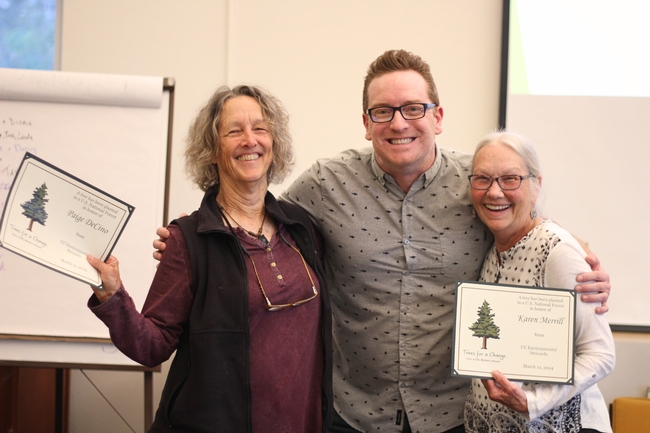
Welcoming a new cohort of environmental stewards
In early March, the longest-standing California Naturalist course in San Diego County graduated 25 new members, Watts being one of them, under Karen Merrill and Paige DeCino's instruction. For seven years, Merrill and DeCino have served as co-instructors at the Buena Vista Audubon Nature Center in Oceanside and graduated 166 members prior to their most recent and final class.
Transitioning into retirement, DeCino and Merrill reflected on their seven years of service and are proud to see younger and more diverse faces join the California Naturalist program. Tucker Shelton, who recently graduated alongside his mom, is among the few young people who have joined the program over the years. A love for nature began when Shelton discovered tide pools when he was just a boy. At 14 years old, Shelton wants to inspire a generation of youth with a passion and care for nature.
“When you're younger and your brain is still developing, you're the most interested in new things. If you find a passion at a young age, you'll most likely grow up with it becoming a part of you,” said Tucker, whose capstone project focuses on an essay about the endangered Townsend's big-eared bat and uses stamp art to raise awareness. His art will be featured and sold at an upcoming exhibit and all proceeds will be donated to the Volcan Mountain Wilderness Preserve in Julian.
Hannah Marquez, another recent graduate, was born and raised in San Diego. She values its cultural diversity and believes connecting the public to nature begins with language. In working with Tecolote Canyon Natural Park and Nature Center in Mission Valley to establish an updated native plant library, Marquez is providing relevant information and resources in English and Spanish.
“A lot of people aren't comfortable using technology, and relying on Google Translate isn't going to cut it,” said Marquez, adding that her parents' limited English inspired this project.
Marquez hopes to interest more people in growing native plants in their backyard and believes accessible information is the first step to doing so.
“This has been so rewarding for us,” said Merrill. “Typically, our students are already involved in the community, but for those who aren't, it's amazing to see them become a part of the community and engage in a way that they haven't before.”
DeCino agreed and said that she really hopes to find new instructors to keep the momentum of California Naturalists in San Diego County alive. “Even though we're retiring, we'll still be around here and there, but its important to us that we pass the torch,” DeCino said.
The future of California Naturalists in San Diego County
What's next for San Diego County, you ask?
“We definitely want to expand in the area. But right now, we're looking for alums who are interested in taking over the program held at Buena Vista Audubon Nature Center,” Freutel said. “I'm also hoping to secure more partnerships throughout San Diego County so that the course is offered in various places, not just North County, which can lead to accessibility concerns.”
Like other students, Marquez commuted an hour, each way, to participate in the UC Environmental Stewards program. “It's a worthwhile course, one that helps people have a positive impact in their own community,” said Freutel.
For Watts, helping people find healing and connection to the world around them – an experience her book, a guide to the powerful healing of bird-watching, discusses – is a priority. “It's not just about watching birds,” she said. “It's about noticing the tree the bird lives in, and the ground the tree is growing in.”
During a nature walk that Watts led for a group of kids, she noticed two sets of footprints in the dirt. Immediately, she could differentiate the two. “One belonged to a raccoon and the other belonged to a deer,” Watts said. “I was so excited that I could tell them apart, and I promise I didn't know this before taking the CalNat course.”
To learn how you can join the UC Environmental Stewards program and become a California Naturalist or Climate Steward, visit: https://calnat.ucanr.edu/Take_a_class/
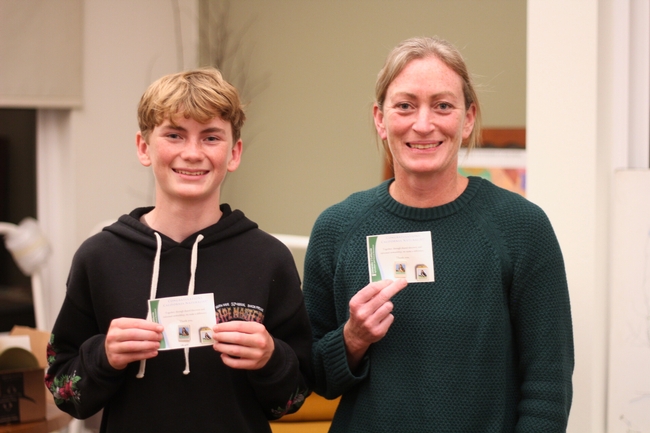
Exploring the why, what and hope in LandBack
The Berkeley City Council recently agreed to purchase a two-acre site (currently used for parking) known as the shellmound and a place of sacred ceremonies and turn over it over to the Sogorea Te' Land Trust, which is planning to restore the site to a place of gathering and ceremonies. This is an example of LandBack.
LandBack is a growing movement focused on returning land to Indigenous people, encompassing various actions to enhance their access to and stewardship of ancestral homelands. To fully grasp the movement's importance, one must understand the history of U.S. law, as rooted in the colonial Doctrine of Discovery, dating back to the late 15th century. This legal and theological concept was rooted in the idea that Christian European nations had the right to claim and control lands that were inhabited by non-Christians to justify European exploration, colonization and the dispossession of Indigenous peoples who were relegated to a non-human status. This worldview facilitated the colonization of new lands and the enslavement of Native people for extracting resources like minerals, animal pelts, forests, range and agricultural production.
The U.S. courts persist in upholding the belief that the U.S. government holds the ultimate right to own and control the land, regardless of the presence and claims of Indigenous peoples. This perpetuation leads to ongoing land dispossession and creates enduring barriers to land access, impeding Indigenous stewardship. Consequently, Native communities experience adverse effects on their well-being, cultural vitality and intergenerational knowledge transfer. LandBack is crucial for Indigenous people to steward the land in a manner that restores their reciprocal relationships dating back to time immemorial.
Some recent policies help enable the principles of LandBack. For example, California law (SB-18, 2004) recognizes tribes' ability to hold conservation easements on land in order to protect cultural resources, enable access and engage in stewardship; and requires state agencies to have tribal consultation policies. The Native American Ancestral Lands Policy (2020) facilitates tribal access, use and co-management of state-owned or controlled natural lands. Goals include prioritizing tribal purchase or transfer of excess land, establishing co-management agreements and providing grants for land procurement and conservation.
The LandBack movement is gaining momentum to address justice, promote Indigenous stewardship, protect the community of life and advance climate resilience thanks to tribal leadership and collaborations with a variety of entities, including individuals, religious institutions, land trusts, and local, state and national governments. Actions range from the full return of land without restriction to more limited agreements including enabling co-stewardship of land, especially on public lands such as federal or state parks, forests, and wildlife refuges.
UC's Tribal Lands Workgroup
Through leadership from the UC Office of President, a systemwide Tribal Lands Workgroup is focusing on the following topics. Members of the workgroup, with assistance from UCANR's Informatics and Geographic Information System, assembled a mapped inventory of UC lands as well as tribal territory and other land cover information. The workgroup has also researched existing systemwide memoranda of understanding or other agreements with tribes related to the use of UC land.
A good example is the memorandum of understanding developed between the UC Hopland Research and Extension Center, which is part of UCANR, and Hopland Band of Pomo Indians (HBPI) who manage neighboring lands. This agreement is designed to increase the educational, research, land stewardship and cultural exchange opportunities between HBPI and UCANR, and delineate areas where we can work together on specific projects. Given the interest in creating these types of collaborative opportunities, this agreement is likely just the first of more to come. This UC workgroup is also exploring the best way to develop and share guidelines for engaging with tribes about use of UC land consistent with tribal consultation processes and existing rules and regulations.
Co-stewardship Workshop
To learn from existing co-stewardship models, several UC scientists including myself, Steve Monfort, director of UC Natural Reserves; and Patrick Gonzalez, executive director of UC Berkeley Institute for Parks, People and Biodiversity; worked with other California Biodiversity Council steering committee members and in partnership with the Federated Indians of Graton Rancheria and with consultation from the Native American Research Institute to organize a workshop titled “Indigenous Co-stewardship of Public Lands: Lessons for the Future.” Funding was provided by the Gordon & Betty Moore Foundation, Resources Legacy Fund and Federated Indians of Graton Rancheria.
This workshop held in February 2024 was well-attended by tribal leaders, Indigenous culture bearers and staff from public land-management agencies, with a total of 536 registered for the livestream and approximately 300 in person.
Chairman Greg Sarris of Federated Indians of Graton Rancheria provided important context, examples of co-stewardship in action from Sonoma County and inspiration to do more. Samuel Kohn, senior counselor to Office of the Assistant Secretary of Indian Affairs, explained the various federal policies and guidelines that relate to co-management with tribes. The heart of the workshop was a series of co-stewardship case studies from California, other states and Canada. These were followed by examples of Indigenous people in Mexico engaging in stewardship and sustaining their livelihoods. A real snapshot of the topic across North America!
We spent the second day together visiting places now known as Point Reyes National Seashore and Tolay Lake Regional Park that have long-term co-management agreements initiated by Federated Indians of Graton Rancheria. A more thorough summary of the workshop can be found at News from Native California by Tavi Lorelle Carpenter.
If you are interested in working with tribes and tribal communities, please join the UC ANR Native American Community Partnerships Workgroup. Contact co-chairs Jennifer Sowerwine at jsowerwi@berkeley.edu and Christopher J. McDonald at cjmcdonald@ucanr.edu.
Car fumes, weeds pose double-whammy for fire-loving native plants
Wildflower displays threatened
Northwest of Los Angeles, springtime brings native wildflowers to bloom in the Santa Monica Mountains. These beauties provide food for insects, maintain healthy soil and filter water seeping into the ground – in addition to offering breathtaking displays of color.
They're also good at surviving after wildfire, having adapted to it through millennia. But new research shows wildflowers that usually would burst back after a blaze and a good rain are losing out to the long-standing, double threat of city smog and nonnative weeds.
A recent study led by Justin Valliere, assistant professor in the UC Davis Department of Plant Sciences, found that native wildflowers and other plants that typically flourish following a fire were, instead, replaced by invasive plants on land that received the kind of nitrogen contained in vehicle emissions.
“Many native plants in fire-prone areas rely on fire, and some are entirely dependent on it. Some are even most abundant after a fire,” said Valliere, a UC Cooperative Extension specialist in invasive weed and restoration ecology. “But we found that these fire-following species may be especially vulnerable to the combination of nitrogen pollution and invasive plants.”
That's part of the reason why native plants in these mountains have been declining.
Seeds – banked in the soil and waiting to sprout
The problem faced by native plants can be compared to a drawn-down bank account: Funds withdrawn are not being replaced.
It starts with fire, an important ecological process, Valliere said. Flames burn through plants on the surface and return their nutrients to the soil. Seeds sleeping in the ground wait for the next rain to sprout, then use those nutrients to grow.
“Plant diversity is often highest in growing seasons immediately after a site burns,” he said.
But invading plants have many advantages over native ones. They often sprout earlier, grow faster and create more seeds, all while tolerating drought.
“They're like cheaters,” Valliere said. “They don't follow the same rules.”
Nitrogen, too, is an important piece of every plant's nutrition. They all get a fertilizing boost from nitrogen that floats up in vehicle emissions and falls to the ground. But the invaders use nitrogen and other nutrients to grow faster, winning the race for water and sunlight. As a result, fewer native plants reach maturity, producing fewer seeds that keep their populations thriving.
When the bank balance reaches zero
The 2013 Springs Fire gave Valliere a unique opportunity to study the combined impacts of wildfire and extra nitrogen. He and colleagues from UC Riverside and the National Park Service created test plots in the Santa Monica Mountains where the fire had burned. Then, they added nitrogen to the soil to mimic the amount and type that LA's smog would deposit. Over the study's three years, native plants that typically would have flourished after wildfire instead declined even faster in the plots with added nitrogen.
Native seeds sprouted, but didn't flower. Over time, the soil's bank of seeds drew down.
“Each seed has one chance to flower and reproduce,” Valliere said. “If a seed grows and gets outcompeted, that seed has lost its chance to replenish the seed bank.”
Without the chance to replenish their bank account, native plants will die out, and the whole ecosystem will be thrown out of balance.
“There is inherent value in biodiversity,” Valliere said. “These invasive weeds could prevent the re-establishment of native shrubs after fire, sometimes forever altering the plant community.”
The loss of native plants can have cascading effects on the larger environment, he added. Problems can include the loss of native bees that feed on the flowers, and mudslides when rain makes hillsides unstable.
This problem is likely to repeat in similar areas where biodiversity is highest after wildfires – including parts of the Mediterranean basin, southern Africa and Australia. The addition of city smog “could have serious consequences for the biodiversity of fire-prone ecosystems worldwide,” Valliere warned.
Read the paper, “Nitrogen deposition suppresses ephemeral post-fire plant diversity,” by Justin Valliere, Irina Irvine and Edith Allen.
This article was first published on the UC Davis Department of Plant Sciences website.
Monarchs on the Move: A Migration and a Bohart Museum Open House
It's Wednesday afternoon, Nov. 1 and a female monarch butterfly flutters into our Vacaville pollinator garden. Me: "Welcome Ms. Monarch! Aren't you a little late for the migration?" Ms. Monarch: "No, I'm just a late bloomer,. so to speak. I'm heading to Santa Cruz to join my buddies for the...
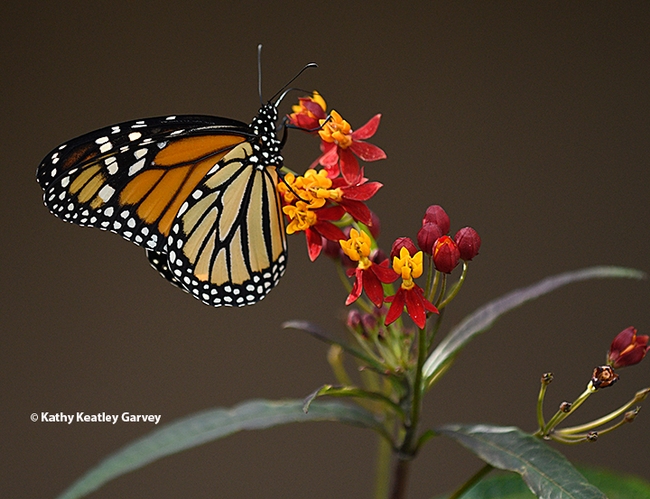
A female monarch butterfly sipping nectar from a tropical milkweed on Wednesday, Nov. 1 in a Vacaville garden. (Photo by Kathy Keatley Garvey)
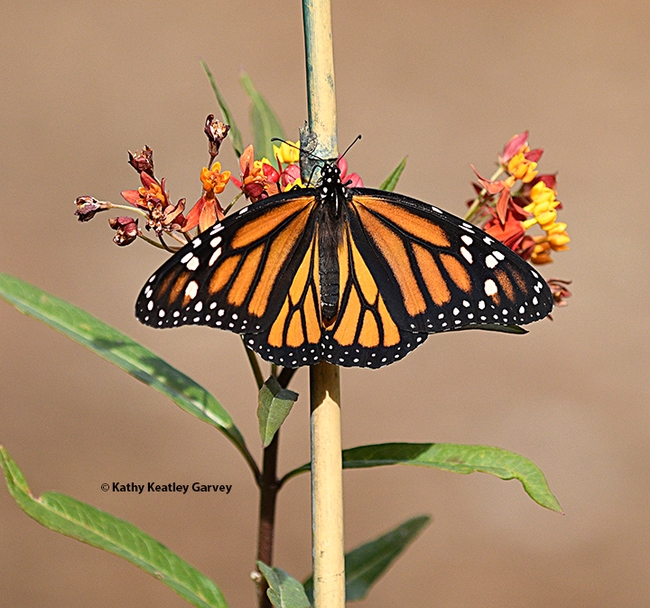
The female monarch spreads her wings. (Photo by Kathy Keatley Garvey)

A little flight fuel and the monarch is off to an overwintering site along coastal California. (Photo by Kathy Keatley Garvey)

